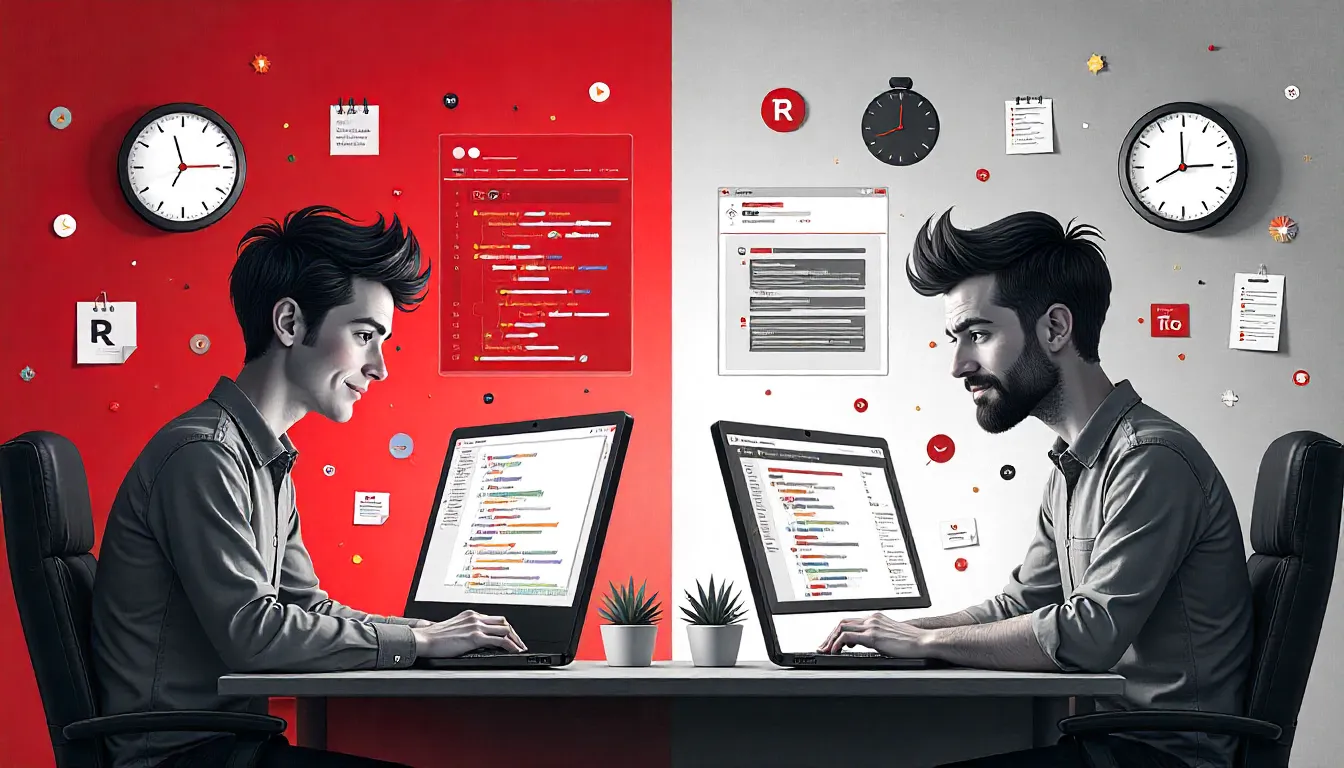Ruby on Rails: Powering the Future of Enterprise Web Development in 2025
The landscape of enterprise web development continues to evolve rapidly, with organizations demanding frameworks that deliver both speed and scalability. Ruby on Rails has emerged as a cornerstone technology for modern enterprise applications, proving that maturity and innovation can coexist seamlessly. While skeptics once questioned Rails’ enterprise readiness, Ruby on Rails is having a much-deserved resurgence because it enables teams to rapidly develop innovative web apps for clients who need to see them deployed quickly.
This comprehensive guide explores how Ruby on Rails has solidified its position as a strategic choice for enterprise web development, examining real-world implementations, scalability solutions, and the framework’s evolution to meet contemporary business demands. You’ll discover why industry giants continue to bet their digital infrastructure on Rails and how your organization can leverage this powerful framework for sustainable growth.
Why Enterprise Organizations Choose Ruby on Rails
Proven Track Record with Industry Leaders
The role of Ruby on Rails in modern enterprise web development extends far beyond theoretical capabilities. Major companies scale massively with Rails: GitHub deploys their 2-million-line Rails monolith 20 times daily with 1,000+ engineers, Intercom handles 150,000 requests/second, and Shopify calls itself “the biggest Rails app in the world”. These success stories demonstrate Rails’ capacity to handle enterprise-scale challenges. Want to build a scalable eCommerce solution like Shopify? Explore our Spree Commerce development expertise built on Rails.
Organizations like Airbnb, Basecamp, and Hulu have built their entire business models on Rails foundations, processing millions of transactions daily. Doximity chose Rails in 2010, and how they’ve been building and scaling their original monolith successfully for the past 15 years. This longevity speaks volumes about Rails’ sustainability in enterprise environments.
Developer Productivity and Time-to-Market Advantages
Enterprise success often hinges on rapid deployment and iterative development. Ruby on Rails enables impressive development speed due to its syntax and extensive library of ready-to-use solutions (gems). This makes it a strategic choice for MVP development and startup projects, saving time and reducing the risk of failure. Planning a SaaS product launch? Our Ruby on Rails SaaS development services accelerate time-to-market with proven methodologies.
The framework’s “Convention over Configuration” philosophy eliminates countless hours of decision-making, allowing development teams to focus on business logic rather than boilerplate code. For enterprises managing multiple projects simultaneously, this translates to significant cost savings and faster time-to-market.
Scalability Solutions for Enterprise Applications
Debunking the Scalability Myth
One persistent misconception about Rails concerns its scalability limitations. However, Rails allows enterprises to develop applications that can accommodate 10,000 to 100,000 users simultaneously. Scalability is one of the strongest features of the framework. The key lies in proper architecture and implementation strategies.
Modern Rails applications leverage horizontal scaling, microservices architecture, and advanced caching mechanisms to handle massive user loads. RoR apps are scalable enough even with minimum cost if you have the right team backing you up with software development.
Enterprise-Grade Performance Optimization
Successful Rails scalability involves several strategic approaches:
Database Optimization: Implementing efficient database queries, proper indexing, and connection pooling ensures optimal performance under heavy loads. Rails’ ActiveRecord ORM provides sophisticated query optimization tools that enterprise developers leverage extensively.
Caching Strategies: Rails offers multiple caching layers, from page and action caching to fragment and low-level caching. Enterprise applications benefit from Redis integration and CDN implementation for global content delivery.
Background Processing: Sidekiq and similar tools handle time-intensive tasks asynchronously, maintaining responsive user interfaces while processing complex business logic in the background.
Load Balancing: Modern Rails deployments utilize sophisticated load balancing strategies, distributing traffic across multiple application servers to ensure consistent performance.
Modern Rails Features for Enterprise Development
Rails 8.0 and Contemporary Innovations
Ruby on Rails 8.0.0 was released on 8 November 2024. This major release introduces fundamental shifts in Rails development, enabling individual developers to host and manage their applications independently without the need for a Platform-as-a-service. This update reflects Rails’ commitment to enterprise autonomy and deployment flexibility.
The latest Rails version introduces several enterprise-focused features:
Enhanced Security: Built-in encryption capabilities and improved authentication mechanisms address enterprise security concerns. Rails continues strengthening its security posture with each release, incorporating industry best practices by default.
Improved Asset Pipeline: Hotwire and Stimulus provide modern frontend capabilities without JavaScript framework complexity, enabling rich user experiences while maintaining Rails’ simplicity philosophy.
Better Testing Framework: Enhanced testing tools support continuous integration and deployment practices essential for enterprise development workflows.
Integration Capabilities and API Development
Modern enterprises require seamless integration with existing systems and third-party services. Rails excels in API development, supporting both RESTful and GraphQL architectures. The framework’s robust serialization capabilities and comprehensive testing tools make it ideal for building enterprise service-oriented architectures.
Rails’ extensive gem ecosystem provides pre-built solutions for common enterprise requirements: payment processing, authentication, monitoring, and database management. This reduces development time while ensuring battle-tested reliability. Our Ruby on Rails API development solutions support robust, scalable integrations with enterprise systems.
Cost-Effectiveness and Resource Management
Development and Maintenance Economics
Enterprise technology decisions increasingly focus on total cost of ownership. Ruby on Rails offers compelling economic advantages through reduced development time, lower maintenance overhead, and extensive talent availability. The framework’s maturity means fewer breaking changes and more predictable upgrade paths.
Rails applications require fewer developers to maintain equivalent functionality compared to more verbose frameworks. This translates to significant savings in human resources while maintaining high development velocity.
Long-Term Sustainability
Rails’ maturity and stability make it a go-to framework for long-term projects, while new features ensure it remains competitive. For enterprises planning multi-year development roadmaps, Rails provides the stability needed for sustained growth while continuing to innovate.
The framework’s backward compatibility philosophy ensures that enterprise applications remain maintainable across version upgrades, protecting technology investments over time. Looking to stay current with the latest features? Check out our Ruby on Rails upgrade services for seamless transitions.
Enterprise Security and Compliance
Built-in Security Features
Rails prioritizes security through its default configurations and built-in protections. The framework automatically guards against common vulnerabilities: SQL injection, cross-site scripting (XSS), and cross-site request forgery (CSRF). These protections activate by default, reducing security oversight risks.
Enterprise applications benefit from Rails’ parameter filtering, secure cookie handling, and automatic HTML escaping. The framework’s security-first approach aligns with enterprise compliance requirements across various industries.
Compliance and Auditing Capabilities
Rails applications easily implement audit trails, user access controls, and data encryption required for regulatory compliance. The framework’s comprehensive logging capabilities support forensic analysis and compliance reporting essential for enterprise environments.
Implementation Strategy for Enterprise Teams
Team Structure and Development Workflow
Successful Rails enterprise implementations require strategic team organization. Cross-functional teams including Rails developers, DevOps engineers, and database administrators collaborate most effectively. Rails’ convention-driven approach facilitates team coordination by establishing shared expectations and practices.
Enterprise teams benefit from Rails’ testing culture, which encourages comprehensive test coverage and continuous integration practices. This alignment supports enterprise quality assurance requirements while maintaining development velocity. For expert assistance with planning and execution, explore our Ruby on Rails consulting services tailored for enterprise teams.
Migration and Legacy System Integration
Many enterprises face the challenge of integrating Rails applications with legacy systems. Rails’ flexible architecture supports gradual migration strategies, allowing organizations to modernize incrementally without disrupting existing operations.
The framework’s database-agnostic approach facilitates integration with existing enterprise databases, while its API capabilities enable seamless communication with legacy systems during transition periods.
Future Outlook and Strategic Considerations
Emerging Trends and Technologies
The Ruby on Rails development trends in 2024 reflect a focus on hybrid app development, asynchronous processing, and improved security through built-in encryption. These trends align perfectly with enterprise development priorities, ensuring Rails remains relevant for future enterprise needs.
The Rails community continues embracing modern development practices: containerization, microservices architecture, and cloud-native deployment strategies. These capabilities position Rails as a forward-thinking choice for enterprise technology stacks.
Strategic Decision Framework
When evaluating Rails for enterprise web development, consider these key factors:
Project Timeline: Rails excels in rapid development scenarios where time-to-market provides competitive advantages.
Team Expertise: Organizations with Ruby experience can leverage Rails immediately, while those without can benefit from the framework’s learning curve efficiency.
Scalability Requirements: Modern Rails handles enterprise-scale traffic effectively with proper architecture and infrastructure support.
Integration Needs: Rails’ flexible API capabilities support complex enterprise integration requirements.
Frequently Asked Questions
The role of Ruby on Rails in modern enterprise web development continues expanding as organizations recognize its unique combination of developer productivity, scalability, and cost-effectiveness. With major companies successfully operating Rails applications at massive scale and the framework’s continued evolution through regular updates, Rails represents a strategic choice for enterprise technology stacks.
Rails 8.0’s recent release demonstrates the framework’s commitment to enterprise needs while maintaining its core philosophy of developer happiness and productivity. For organizations seeking a mature, battle-tested framework that can grow with their business, Ruby on Rails offers compelling advantages that extend far beyond initial development cycles.
The framework’s proven track record, combined with its active community and continuous innovation, positions Rails as a cornerstone technology for enterprise web development well into the future. Organizations investing in Rails today are building on a foundation designed for sustainable, long-term success in the ever-evolving digital landscape.







